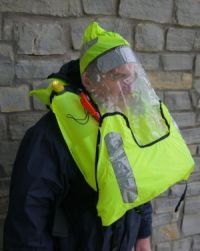Lifejackets save lives – all the evidence indicates that a correctly fitted lifejacket will significantly improve your chances of survival if the unforeseen or unfortunate occurs. Not only will a lifejacket keep you afloat and allow you to adopt the HELP position that minimises heat loss (Heat Escape Lessening Position), it should turn an unconscious casualty to keep the airway above the water, writes Peter Williams.
A point to note is that water takes away body heat at a rate 26 times faster than air and that Cold Water Shock can cause a degree of incapacitation immediately on entry into the water.
The inflated jacket also provides a much more visible target for would be rescuers. A lifejacket should have as standard fitting a whistle and reflective tape. But a lifejacket fitted with crutch straps, a spray hood (Royal Naval research says it increases your survival chances by up to 60%) a light which is in date (and you know where it is and how to operate it quickly) becomes much more effective should you find yourself unexpectedly in the water.
Lifejacket design has progressed and modern lifejackets are compact, lightweight and easy to wear. The correct fitting of the lifejacket is vital so that it functions correctly for the wearer – this is an extremely important aspect of the design of the lifejacket.

Peter demonstrating the spray hood and light
Around 30% of lifejackets checked each year by RNLI Sea Safety Advisers would fail to operate correctly when deployed – this is a very scary statistic which can be reduced with a few simple checks.
- The webbing should be free from broken stitching and buckles and fasteners should operate freely and correctly.
- The inflation chamber should be in good condition and not abraded or punctured, the cylinder should be free of corrosion which could cause chaffing or puncturing of the inflation chamber.
- The inflation mechanism should operate correctly with the inflation cylinder screwed in securely (do not over-tighten), the weight of the fully charged cylinder is marked on the outside and can be checked by weighing on postal scales.
- Auto inflation cartridges should be in date and not “fired” and the jacket should be inflated using a dinghy or hand pump and remain inflated for 24 hours.
- Periodically open and wash lifejackets with fresh water to remove salt deposits then allow to dry thoroughly before repacking, following the manufacturers diagrams to prevent the inflation bladder twisting when inflated.
- From time to check the manufacturer’s website to see if your lifejackets are subject to recall for correction of design or manufacturing faults.
- Lifejackets should be serviced in accordance with the manufacturer’s service instructions and this can be arranged through most local chandlers.
RNLI Sea Safety Advisers will be pleased to provide advice and guidance on selection, inspection and fitting of lifejackets.
A really bad time to discover a faulty lifejacket is when you are in the water and dependent on it for survival!
- Despite what your Mum said about the water holding you up it’s not true, as the average adult needs around 5kg of buoyant assistance or 50N to stay afloat without movement of the arms and legs.
- The water around our coasts is cold ranging between 9-14 degrees (if we are lucky) over the course of a year. If you find yourself in the water the most important thing is to keep warm by adopting the HELP position – Heat Escape Lessening Position by keeping your arms close to your body to protect the armpits and hands folded across the groin to prevent heat loss from these key areas. The legs should be slightly bent and brought up towards the body.

